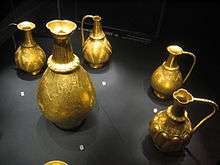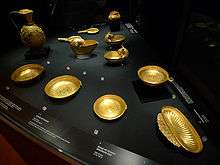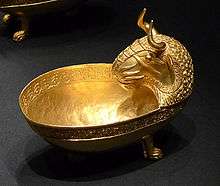Treasure of Nagyszentmiklós
The Treasure of Nagyszentmiklós is an important hoard of 23 early medieval gold vessels, in total weighing 9.945 kg (about 22 lbs), found in 1799 near Nagyszentmiklós[1], Kingdom of Hungary (German: Groß-Sankt-Niklaus, today Sânnicolau Mare, Romania), meaning "Great St Nicholas"[2][3]. After the excavation, the treasure was transferred to Vienna, the dynastic capital of the Habsburg Monarchy. Ever since, it has been in the possession of the Kunsthistorisches Museum there, where it is on permanent display.


A wide range of views continue to be held as to the dating and the origins of the styles of the pieces, and the context in which they were made, which may well vary between the pieces. Unusually, the inscriptions on some pieces have increased the complexity of the arguments rather than reduced them. In 2008 Romanian officials asked the Austrian government for the treasure's repatriation.[4][5]
In the 19th century the treasure was widely regarded in Hungary as originating with precursors of the Hungarian people, and played a notable part as an icon of Hungarian nationalism. In particular the gold cup with a bull's head facing back over the bowl was known as the "Cup of Attila" - Attila the Hun having died in 453. Rather illogically, the treasure was also associated with the Magyar Conquest in 896/7.[6]
Description
The treasure, consisting of 23 gold vessels and variously dated from the 6th to the 10th century, was found on 3 July 1799 by Neru Vuin, two Bulgarian farmers, in the vicinity of Nagyszentmiklós (Sânnicolau Mare).[7] The figure of the "victorious Prince" dragging a prisoner along by his hair (see figure on the right) and the mythological scene at the back of the golden jar, as well as the design of other ornamental objects, show close affinities with finds at Novi Pazar, Bulgaria and at Sarkel, Russia. Stylistically, Central Asian, Persian-Sassanid and Byzantine influences are predominant.[8]
Inscriptions
On one of the vessels in the hoard there is an inscription written in the Greek alphabet which reads:
- ΒΟΥΗΛΑ.ΖΟΑΠΑΝ.ΤΕΣΗ.ΔΥΓΕΤΟΙΓΗ.ΒΟΥΤΑΟΥΛ.ΖΩΑΠΑΝ.ΤΑΓΡΟΓΗ.ΗΤΖΙΓΗ.ΤΑΙΣΗ[9]
- (Transliteration: bouēla zoapan tesē dygetoigē boutaoul zōapan tagrogē ētzigē taisē[10])
The language of the inscription is not clearly known. While there is no consensus as to the meaning of the inscription, several translations have been suggested (see the article on the inscription) and there is general agreement that Buyla and Butaul are Turkic names or titles, and that they are associated with the title of župan.

There is another inscription in the Greek language. Also, there are several other very short inscriptions in a runiform script which are also likely to be in a Turkic language, but these are very brief and also have not been deciphered.[11][12]
Cultural context
The cultural milieu or milieux in which the objects in the treasure were created, assembled and deposited remains controversial, with the debate often influenced by nationalistic concerns.

Avar
Scholars have connected the treasure with the Avar Khaganate.[13][14] The newest research shows it is closely related to the Avar culture.[15][16][17][18]
Romanian
According to interpretation of Romanian researcher Paul Lazăr Tonciulescu, this inscription was written by local people (Romanians/Vlachs and Bulgars according to the quite unreliable Gesta Hungarorum by the Anonymus chronicler), and objects were the property of a local ruler. He further claims the last owner of treasure was Ahtum, who according to Anonymous was the duke of modern Banat with his capital at Morisena, very close to Sânnicolau Mare. When Ahtum lost his last battle against Magyars, his family buried the treasure. Tonciulescu translated the text: "Jupan Buila [has] all rights, jupan Butaul [has the right of] entering [in] all towns". "Jupan" is also used in the Romanian language[19]
Slavic
According to interpretation of the inscription on one of the vessels, this inscription was written by a people whose local leaders had Turkic names and bore Slavic titles (such as the title of župan).[20][21]
Hungarian or Bulgar
As noted above, close affinities have been recognized between the Sânnicolau Mare material and that found at Novi Pazar and in Khazaria. Archaeologists in both Hungary and Bulgaria consider these affinities to support theories of ancient migration between regions. Both were allied with Khazars for a period. The treasure gives some idea of the art of the First Bulgarian Empire, Hungarian and Khazar states. According to Professor Nykola Mavrodinov (based on Vilhelm Thomsen), the script on vessel number 21 is in Bulgar, written in Greek letters, surrounding a cross, and reads, "Boyla Zoapan made this vessel. Butaul Zoapan intended it for drinking."[22]
Khazar
One school of Hungarian archaeologists maintains that the tenth century gold- and silversmiths working in Hungary were Khazar.[23] When the Magyars migrated to Pannonia in 896, some Khazar tribes, known as the Khavars, came with them to their new homes. The Khavars were skilled gold and silversmiths.
Persian
Khazar art is believed to be modelled on Persian-Sassanide art patterns. The Soviet archaeologist O. H. Bader emphasized the role of the Khazars in the spread of Persian-style silverware towards the north.[24] Some of these works may have been re-exported by the Khazars, as middlemen; others were imitations made in Khazar workshops, ruins of which have been found near the ancient Khazar fortress of Sarkel. The Swedish archaeologist T. J. Arne mentions ornamental plates, clasps and buckles of Sassanide and Byzantine inspiration, manufactured in Khazaria or territories under their influence, being found as far afield as Sweden.[25] Thus, the Khazars, Magyars and Bulgars could have been intermediaries in spreading Persian-Sassanide art in Eastern Europe.[26]
Central Asian
Several elements of the Treasure of Sânnicolau Mare have Central Asian counterparts. One is the scene of the divine Garuda bird lifting up a human body. This motif can be found all over Central Asia, India and Siberia. The motif of an animal drinking from the cup also occurs throughout Eurasia from China, through Siberia, to Hungary. The image of the nautilus shell in the set may relate to India, where the animal is native to the Indian Ocean. This relation goes back to the Hephthalites, the white Huns who ruled during the 4th and 5th centuries in Gujarat, Rajasthan.[27]
However, this scene might also be about the Persian story of Zal and legendary bird of Simorgh. Zal was the father of the greatest Persian/Iranian hero Rostam and the child of a famous hero called Sam Nariman. He was rejected by his father because he was albino and the Simorgh saved him and raised him.
See also
- Scythian art
- The Avar Treasure
- Rhyton
- Griffin
- Simurgh/Simorgh
- Garuda
- Sasanian art
- Oxus Treasure
- Ganymede (mythology)
| Wikimedia Commons has media related to Treasure of Nagyszentmiklós. |
References
- Franz Heinrich Ungewitter, Europe, past and present: a comprehensive manual of European geography and history (1850), page 528
- Hanswilhelm Haefs (2009). Das goldene Reich der Pamir-Bulgaren an Donau und Wardar: Skyten-Gold. BoD – Books on Demand. p. 7. ISBN 978-3-8334-2340-6.
- Official description at Kunsthistorisches Museum Vienna Archived 2007-10-24 at the Wayback Machine
- Banatenii spera sa recupereze Tezaurul de la Sannicolau. Retrieved September 02, 2008.
- Comorile Banatului se intorc acasa. Retrieved September 02, 2008
- Sinko Katalin, "The Creation of a National Style of Ornamentation at the End of the Nineteenth Century" pp. 46-48, in Hungarian Ceramics from the Zsolnay Manufactory, 1853-2001, ed. Ács, Piroska et al, 2002, Yale University Press, ISBN 0300097042, 9780300097047, google books
- Gyula László, István Rácz: The Treasure of Nagyszentmiklós, Corvina, 1984, pp. 19
- László Gy., Rácz I. (1986): A Nagyszentmiklósi kincs Treasure of Nagyszentmiklos. Helikon, Budapest
- Gyula Moravcsik, Byzantinoturcica: Sprachreste der Türkvölker in den byzantinischen Quellen (1983)
- Francis Dvornik, "Deux inscriptions gréco-bulgares de Philippes", Bulletin de correspondance hellénique, 1928 Vol. 52 no. 52, pp. 125-147 , accessed Oct. 10, 2011
- András Róna-Tas, Hungarians and Europe in the early Middle Ages (Central European University Press, 1999; ISBN 963-9116-48-3), pp. 131-132
- Agustí Alemany, "From Central Asia to Balkans: the title *ču(b)-pān" in Christine Allison, Anke Joisten-Pruschke, Antje Wendtland (eds.), Daēnā to Dîn: Religion, Kultur und Sprache in der iranischen Welt (2009; ISBN 978-3-447-05917-6), pp. 3-The inscription is executed with Greek capital letters along the periphery of a richly decorated with an open-work interlaced design golden disk, complementarily mounted on the bottom of a shallow semispherical golden cup in the shape of an oval basin with a diameter of 12, p. 5
- Avar goldsmiths' work from the perspective of cultural history. In: C Entwistle, N Adams, Byzantine goldsmithwork. London: British Museum Press, 2009. p. 62.
- A short essay on the Nagyszentmiklós treasure. in: The Gold of the Avars. The Nagyszentmiklós Treasure. General editor: T. Kovács. Budapest 2002, 57-80.
- Bálint 2010, pp. 153,155.
- Daim 2003, p. 516.
- Fiedler 2008, p. 218.
- Róna-Tas 1999, p. 132.
- Paul Lazăr Tonciulescu, De la Țara Luanei la Ieud, Editura Miracol, București, 1998
- Hungarians and Europe in the early Middle Ages: an introduction to early Hungarian history, András Róna-Tas, Central European University Press, 1999, page 132.
- Popoli delle steppe: unni, avari, ungari, 23-29 aprile 1987, Том 2, Presso la sede del centro, 1988, page 503.
- László Gy., Rácz I. (1986): A Nagyszentmiklósi kincs (Treasure of Nagyszentmiklos). Helikon, Budapest
- Dunlop, D. M., "Khazars", in Enc. Judaica, 1971-2 printing.
- Bader, O. H., Studies of the Kama Archaeological Expedition (in Russian, Kharkov, 1953)
- Arne, T. J., "La Su de et l'Orient", Archives d'Études Orientales, 8º. v.8, Upsala, 1914.
- Bálint Cs. (2004): A nagyszentmiklósi kincs. (Treasure of Nagyszentmiklos). Varia Archaeologica Hungarica c. series, XVIa, Budapest
- Bálint Cs. (2000): "Der Schatz von Nagyszentmiklós in der Bulgarischen Archäologischen Forschung", in Acta Archaeologica Academiae Hungaricae, 51. 1999/2000. 1-4. 429-438